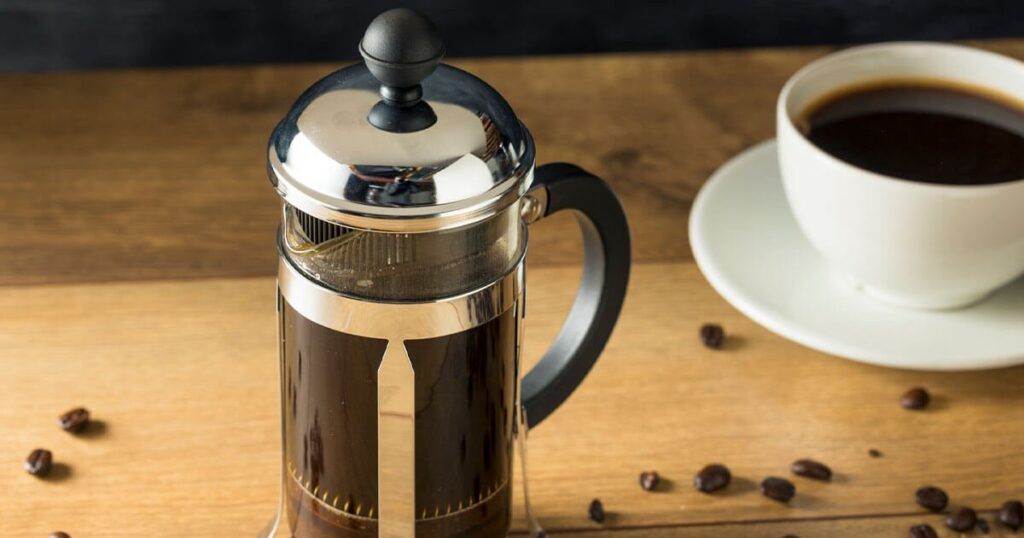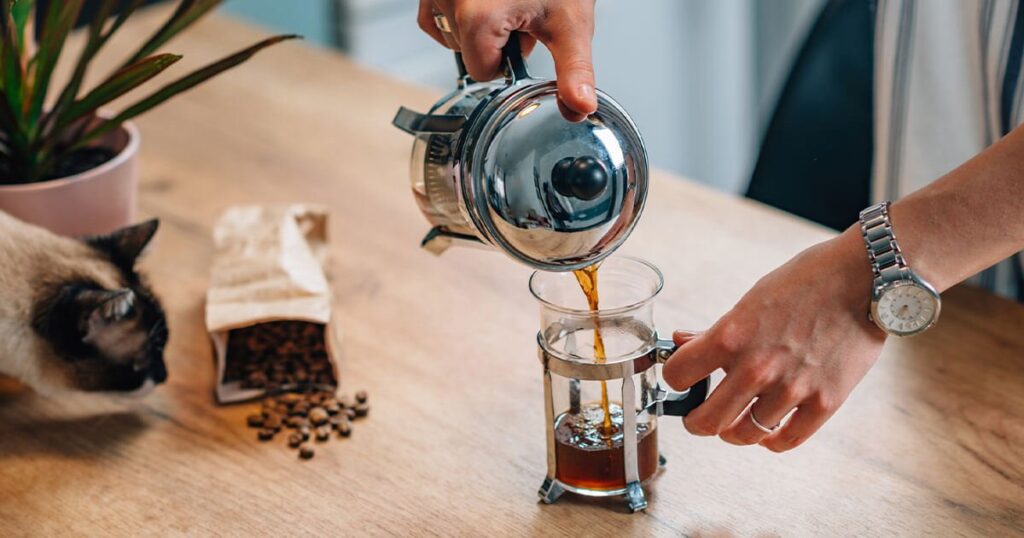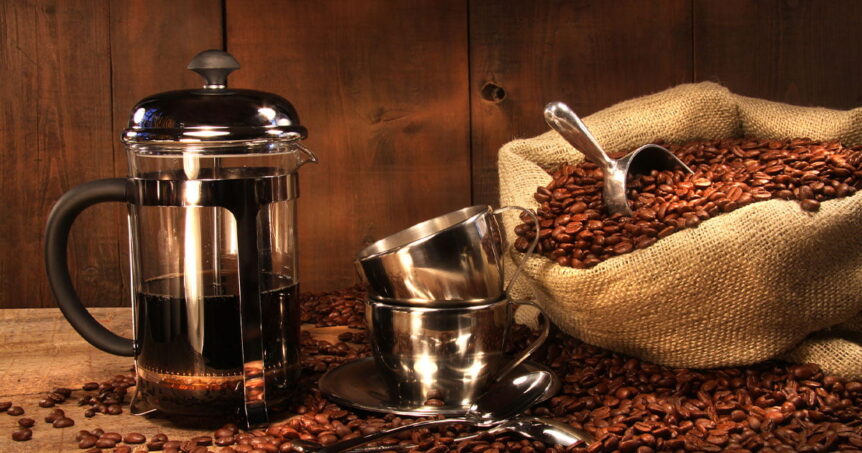French press coffee is made with an iconic brewing technique that has allowed coffee lovers to brew the perfect cup of joe for over a hundred years.
Steeped in rich tradition and celebrated worldwide for its robust flavors, the humble French press coffee has enchanted generations of coffee enthusiasts. Mastering this technique is not easy. It takes time, a lot of practice, and some helpful tricks and tips to perfect your coffee skills.
In this ultimate guide, we delve into the rich aromatic world of French Press and break down its origins, equipment essentials, precise brewing steps, and more.
What is French Press Coffee?
French press coffee is a full-body and rich coffee brewed by steeping the grounds in hot water and filtered using a piston (plunger).
The French press (or Cafetière) has a unique single-container design that can brew and filter the coffee. It has a metal filter disk embedded in the lid of the container, attached to a protruding handle.
The coarse ground coffee enters the press, followed by a hefty amount of almost boiling water. The hot water mixes and melds with the coffee grounds extracting all those flavorful compounds. Finally, the piston gets pushed down, and the sweet, rich coffee passes through, leaving behind unwanted solids.
Since the French press doesn’t use a paper filter, the final cup of joe retains all the essential coffee oils, resulting in a richer and more natural mouth feel.
Nothing beats the comfort of brewing a fresh cup of coffee using the simple and elegant French Press.
The bold and rich taste of the French press enables the creation of different coffee beverages. Add ice, cream, chocolate, matcha, or cinnamon to make your ideal coffee drink.
What is a French Press Coffee Made Of?
A delicious cup of French press coffee is made with three simple ingredients. Coarsely ground coffee beans, hot water, and a little bit of patience.
You need a coarser grind to match the filter tolerance of the French press. A fine powder-like grind will pass through the filter and right into your cup.
The water needs to be filtered for the best results. Unfiltered fresh water can bring odd flavors to your morning dose of brown goodness.
The History of French Press Coffee

Our journey into the history of the French press takes us all the way back to 1852. Where two Frenchmen, Henri-Otto Mayer, a metalsmith, and Jacques-Victor Delforge, a merchant, collaborated to find the ideal coffee brewing method.
In the 1800s, the drip was the only real coffee brewing technique. The two Frenchmen sought a more user-friendly method for the average household.
Although Mater & Delforge’s patent was submitted in 1852, it was still a far cry from the modern French press. It didn’t have a seal around the piston resulting in poor filtration consistency.
Surprisingly the modern French press design was developed by two Italian designers, Giulio Moneta and Attilio Calimani. The two men sought to improve the flawed French design by adding spring-loaded seals to the piston. In 1929 the new Italian design was then patented in the US.
But there is still more to this fascinating story. We now jump to a Swiss-born inventor, Faliero Bondanini. This man should be credited as the inventor of the modern French press coffee maker.
In 1958, Faliero created and patented an even more refined design that uses a dome-like metal sheet with curled edges for a better seal.
But the life of an inventor is always about improving oneself. So in 1987, Faliero designed a filter mechanism using a fine wire mesh as a filter in place of the older perforated metal sheet.
Faliero’s design was manufactured in France, where it gained its uniquely French identity and the name “cafetière à piston” (coffee maker with a piston).
The French press’s history is full of creative thinkers, designers, and inventors. It is also full of litigation from several companies over the ownership of the design. Outside the US, a Danish-Swiss manufacturer holds the patent for the French press. Claiming that the modern design was invented by a Danish inventor, Jørgen Bodum, in the 1970s.
Regardless of its modern-day origins, the French press is deeply entwined with the French coffee culture.
What are the Pros and Cons of French Press Coffee?
The French press coffee is a particular favorite among coffee enthusiasts. But like any brewing method, it has some pros and cons. We’ve broken down this complex topic into a simpler and more manageable list.
Pros
- Easy to Brew
- Easy to Master
- Easy Cleaning
- Inexpensive Coffee Maker
- Rich Full Body Taste
Cons
- Risk of Coffee Sludge
- Coffee Oils Can Raise Cholesterol
The limitations of the French Press become much more apparent when it’s compared to other brewing methods. For example, it can’t deliver a flavorful punch like a shot of espresso.
Why is a Coffee Grinder Important for French Press Coffee?
A French press requires a good consistent ground size. The holes in a French press plunger are designed for coarse grind. Anything finer will pass through the filter and muddy your nice clean coffee.
Either electric or manual coffee grinders will do the job. But serious coffee drinkers should invest in an electric burr grinder for its fast, versatile, and consistent results.
Alternatively, you can use pre-ground coffee, but it just doesn’t taste the same. Why go through the effort of brewing fresh coffee in the morning if you don’t use freshly ground beans?
What is the Ratio of Water and Coffee for French Press?

The ideal coffee-to-water ratio for French press is 1:16. Which is 30 gm of coffee for 480 gm (16 oz.) of water. Coffee lovers who prefer a stronger cup in the morning can go as low as 1:12.
We know that the amount of water doesn’t change the extraction rate. So whether you’re using a 16 oz. or 12 oz., your brew time will remain the same.
Hence, the only concern with using less water is that your brew will cool down faster since there is less mass to retain that heat.
How to Choose your Coffee for a French Press?
French press is best suited to medium and dark roasts. Your beans should be processed to a coarse grind, with optional medium-coarse for a richer extraction.
Light roasts will need a longer steep time, resulting in your coffee getting colder before the extraction completes.
How Much Caffeine is in a French Press Coffee?
A standard 8 oz. cup from any coffee shop will have approximately 11.8mg of caffeine per 1 oz. of coffee.
Compensating for the filtered water used in the French press and the type of roast, we conclude 80-135 mg of caffeine per 8 oz. cup.
The large variation in caffeine content comes from the difference in roast, brewing temperature, and brew time.
How Many Calories Are in a French Press Coffee?
A cup (8 oz.) of freshly brewed French press coffee will have ~2 calories. Adding milk, sugar, or cream will increase the calorie level.
More importantly, the French press produces a coffee with a higher fat content as it doesn’t have a paper filter to absorb those aromatic oils.
How to Make French Press Coffee? – In 7 Simple Steps

We believe making the perfect cup of coffee using a French press is simple and intuitive. All you need is the right ingredients and a little bit of patience.
By the end of these seven simple steps we’ll have changed your mind.
Step 1: Heat Water
Fill a kettle with filtered water and set it to boil. Hot water is the key to good French press coffee. As you steep your delicious ground beans, the temperature slowly goes down.
The best water temperature for French press coffee is around 200°F, just below boiling point.v
Filtered water is a must for good extraction, regular tap water contains minerals that can affect the taste of your coffee.
Step 2: Grind Your Coffee
While you wait for the water to heat up, pick your favorite pack of coffee beans and grind them to a coarse consistency.
An electric burr grinder is helpful here but not necessary. Manual grinders will also do a suitable job.
Step 3: Measure and Add Coffee to the Press
Add 30 gm (~2 Tbsp) of your ground coffee for a nice and rich extraction. A kitchen scale is recommended here to help you fine-tune your coffee brewing technique.
Step 4: Slowly Pour the Water
If your water is boiling, let it sit for 30 seconds before pouring. Carefully add the water to the coffee in a gentle round motion. You want the coffee to completely absorb the water and get saturated.
Gently stir using a spoon, break down any dry clumps, and cover the press with its lid.
Step 5: Let the Coffee Steep
Now just wait. Let the coffee and water get to know each other. Wait 4 mins for the coffee to brew and 1 min for the coffee particles to settle.
The extra minute is necessary, especially if you stirred your coffee.
Step 6: Gently Push the Plunger Down
Now push the plunger down slowly, you don’t want to agitate the coffee solids at the bottom. Stop once you’ve reached the coffee solids.
Do not press further unless you like coffee sludge at the bottom of your cup.
Step 7: Pour Your Fresh Hot Coffee in a Cup
Now carefully tilt the French press and pour your delicious liquid into a cup. You only need to pour about 70% of the coffee, the rest is unwanted coffee sludge.
Add milk, sugar, and other desired additives, and enjoy your coffee.
Best French Press Coffee Recipe

Equipment
- French Press
- Coffee grinder
- Kettle
- Coffee Cup
- Kitchen Scale
Ingredients
- 2 tbsp Dark Roast Coffee: 30gm of Coarse Grind
- 2 cups Water (~480 gm)
Instructions
- Heat the water in a kettle.
- Select coarse grind settings for your beans.
- Add the coffee to the French press.
- Gently pour the hot water over the coffee.
- Stir with a spoon to saturate all the coffee with water.
- Wait 4 mins for the coffee to brew and 1 min for the particles to settle.
- Slowly plunge the filter down until it's just above the coffee particles.
- Pour the coffee into a clean cup, and avoid the last bit of sediment-filled coffee at the bottom.
How to Clean a French Press?
A French press is very easy to clean. It takes less time to clean than it takes to brew coffee.
Pour water into your press and strain it into the sink through a strainer (fine mesh). Keep the coffee sludge away from the sink.
Otherwise, it will get clogged.
Next, dump the coffee grounds from your strainer into your dustbin.
Use warm water and soap for the french press.
Move the plunger up and down several times, dislodging stuck coffee particles from the sides and removing oil collected in the filter area.
Do a thorough rinse with clean water.
Dry it with a lint-free cloth and store it in a cool, dry place.
While all parts of a French press are dishwasher safe, cleaning by hand is generally a lot quicker.
Frequently Asked Questions
What is Special about French Press Coffee?
French press coffee doesn't require paper filters, so it retains the aromatic oils of the beans. Additionally, since no active heating is involved, there is little chance of burning your coffee.
Is Coffee from a French Press Better?
The French press coffee is less intense and lacks the subtle bitterness of an espresso shot. All while maintaining a better extraction compared to pour-over coffee
Also, unlike drip coffee, it retains aromatic oils, which lead to a richer coffee flavor and smoother mouthfeel.
How Much Coffee Do You Use in a French Press?
Add 30 gm of coarse ground beans and 2 cups (16 oz.) of water in a French press for a single serving of coffee.
Is it OK to Drink French Press Coffee Everyday?
Yes. French press coffee is safe to drink daily. It has less caffeine than the daily limit for adults, and the aromatic oils are only concerning if you drink 4-5 cups a day.
Is French Press Coffee Healthier than Drip?
French press coffee is as healthy as any other type of coffee. However, if you drink 4-5 cups of coffee a day, the oils in a French press can increase your cholesterol.
What Coffee Tastes Best in a French Press?
A dark roast tastes best with a French press. The gentle heat from steeping extracts all the nutty and chocolatey notes without dipping into the bitter ones.
Can you use Regular Ground Coffee in a French press?
The French press is compatible with all coarse-ground coffee. If your coffee is too fine, it will pass through the filter of a French press.
How Long Do You Steep Coffee in a French Press?
You want to steep your coffee for at least 4 mins for the best extraction. You can steep for 5 or 6 mins for medium and lighter roasts, respectively.
How Long Do You Wait to Push Down a French Press?
Wait at least 4 mins for your coffee to brew. Then gently push the plunger down until you are just above the coffee solids.
How Much Coffee do I Need for 1 Cup of French Press?
You need 30 gm of coarse-ground coffee to get a good extraction from a French press.
Final Thoughts
By going through this entire article you are now fully informed and educated on French press coffee. With a little bit of practice you are sure to become a master brewer.
From the fascinating history of its invention to its modern place in our kitchens. The French press has established itself as an easy-to-use, versatile, and capable brewing device.
This simple brewer allows us to optimize and personalize our brewing habits and get that perfect cup of coffee in the morning.

